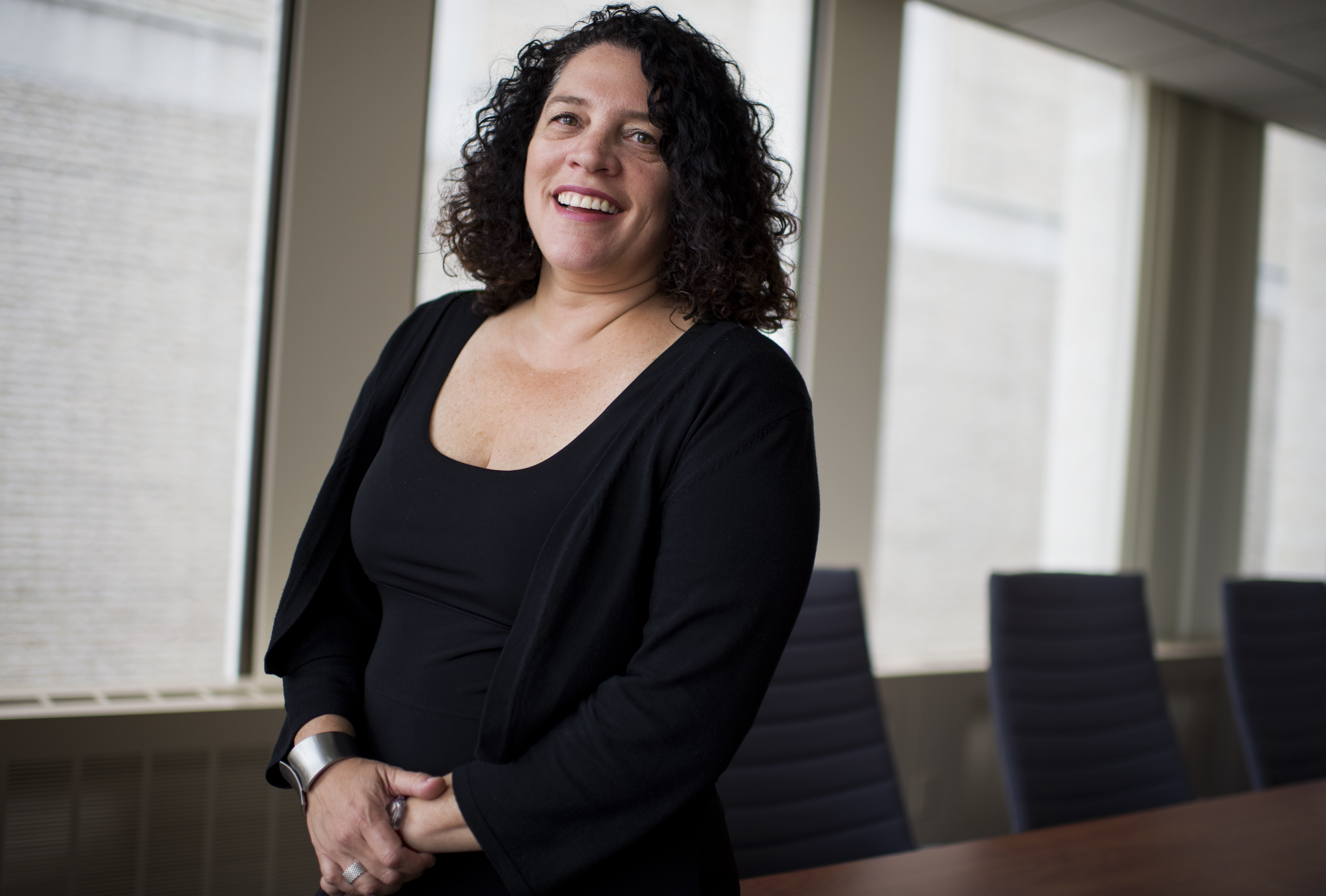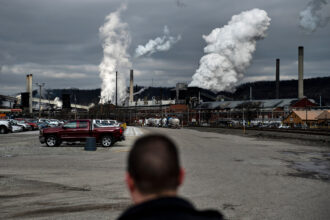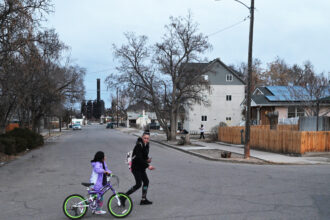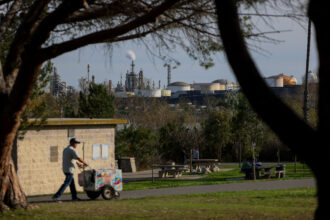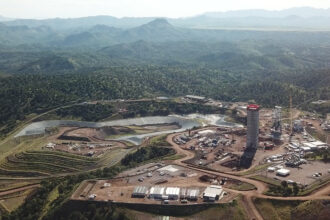As a child, Lisa Garcia spent her summers in a South Bronx where playgrounds had more cracked pavement and asphalt than grass. She biked or hung out on stoops with her friends. She considered herself outdoorsy, even if the outdoors looked a little different in the working class neighborhood of Soundview.
“Literally no one I grew up with knew that there was actually a Bronx River,” Garcia said. “When we were growing up, the Bronx River was a parkway.”
The 24-mile waterway—New York City’s only freshwater stream—runs beneath the Bruckner Expressway and Sheridan Boulevard and parallel to the Bronx Parkway. Back then, few children knew it was there. Fewer went near it. Green spaces were squeezed in pockets between concrete. Garcia, who was asthmatic, remembers the air as acrid with exhaust that triggered some painful coughing fits.
Only much much later did she learn that there likely was a connection between her health and her Bronx surroundings.
Garcia, 58, has spent nearly three decades fighting for environmental justice in the courts and through laws and regulations that ensure the right to live in safe, healthy environments with equal protections. At the Environmental Protection Agency, she served in the Biden administration as administrator for Region 2, covering New Jersey, New York, Puerto Rico, the U.S. Virgin Islands and eight Native Nations.
Before that, she served as associate administrator and senior advisor to EPA Administrators Lisa P. Jackson and Gina McCarthy during the Obama administration and focused on environmental justice planning, helping build widely available online maps that showed, block by block, where pollution and people overlap.
Now environmental justice is under attack. President Trump’s administration has taken a torch to the EPA website, eradicating what Garcia, among others, built to encourage more investigation and public participation in environmental protections. Garcia, too, was part of the upheaval: she was among the political appointees in the Biden Administration who resigned in January after the November election.
“When you take the job as a political appointee, you know in four years you may be out of a job,” Garcia said. Still, the last few months of the Trump era have been disorienting. “What I did not foresee is the complete dismantling of the work and the disrespect for the workers.”
It might be time for the fight for environmental justice to take a different approach—or adopt different ways to get more communities on board, she said.
How to do that keeps her up at night, Garcia said. How can activists hope to incorporate environmental justice into government entities now? What practices make the most sense, what lessons were learned, and, how can she offer new ways to help people compile evidence and facts? People still live in polluted, unhealthy neighborhoods. People are still getting sick. People still need to know that there are laws and regulations that should be protecting them, she said.
Environmental justice advocates, Garcia said, may have to talk differently and be increasingly careful with language. Terms like “environmental justice” and “climate change,” have become so politicized that they can stop conversations even before they begin.
Keeping the conversations on shared health risks and benefits may be the answer. “It’s not over,” Garcia said over a cup of coffee in Union Square, laying out the need for remediation for industrial pollution still troubling many low-income neighborhoods.
Garcia said she first considered environmental justice when she was a student in Spain, attending law school in 1999. Garcia, an avid international traveler and fluent in Spanish, was initially drawn to human rights, but an environmental law class changed that. Human rights and environmental law became inseparable in her mind.
Not long after, Garcia began to think back to her childhood asthma and the exhaust that drifted through Soundview. It was her “ah-ha,” moment. Since then, Garcia’s career has shifted between government and nonprofit work. She said she is most satisfied “in the trenches” with people, including five years working for EarthJustice, the public interest law organization.
“Environmental justice” crystallized as a concept in the late 1980s, and the movement gained national attention when residents in Warren County, North Carolina, protested a proposed landfill that would be designated as a dump for products laden with polychlorinated biphenyl. PCB is a manmade chemical used in fire retardants and some adhesives and plastics that is banned in many countries as a toxin.
Republican President Richard Nixon had created the EPA years earlier, in part from public demand–and legal challenges—to regulate pollution in the air and in waterways. Environmental justice addressed those same concerns, she said, with a focus on those most impacted, namely low-income communities and people of color.
The rationale was simple and rooted in equity. “Why not have everyone have parks, clean air and clean water to swim in?” she said.
There were decades of progress under both Republican and Democrat administrations. Garcia helped create “Plan EJ 2014,” under President Barack Obama, which was the first strategic plan for weaving environmental justice throughout EPA funding and projects.
She worked with colleagues to embed environmental justice criteria in launching EJSCREEN publicly in 2015, so that anyone could type in a ZIP code to add to the growing sets of data. But in January, in the first week of the second Trump presidency, all bets were off. The EJSCREEN tool is gone now. That part of the website doesn’t exist.
“There’s a certain pride that we must have been doing something right when we created EJSCREEN if the Trump administration feels like you can’t even have access to it,” Garcia said, smiling. Experts had the foresight to take screenshots before the site went dark. “A lot of it is preserved. It’ll be static, but at least it’s not lost completely.”
Trump’s administration has gutted most broad protections and, within weeks, revoked any prior executive orders involving environmental justice. When Trump signed executive order 14151, “Ending Radical and Wasteful Government DEI Programs and Preferencing,” EPA funding was no longer assured for existing programs. The next month, he cancelled pivotal environmental and climate block grants worth $3 billion.
Garcia said these actions shouldn’t have been so easy to do. And the administration’s decision to fire EPA staff and cut federal funding for programs, she said, is a step backward. A clean and healthy environment is a goal that should not be controversial, she said.
Garcia said Trump, in his first presidency, did not target the EPA so aggressively, and many safeguards and programs survived. But the Biden administration took a different approach from an Obama-era EPA, she said, by creating a separate office to prioritize environmental justice. In 2022, a national program, the Office of Environmental Justice and External Civil Rights was born.
This story is funded by readers like you.
Our nonprofit newsroom provides award-winning climate coverage free of charge and advertising. We rely on donations from readers like you to keep going. Please donate now to support our work.
Donate NowFor the first time, there was a lot of money and over 200 people at the EPA dedicated to the movement. That too now is gone. The Trump administration was “able to destroy it,” she said.
Still, post-EPA, Garcia continues to pivot through the challenges. Today she continues her work through lecturing at both Columbia University and New York University, on environmental law. She’s also working on a project to improve New York State’s watershed program, and still attends hearings held by the former White House Environmental Justice Environment Committee.
She doesn’t plan on stopping her work any time soon, despite all the pivoting. The federal government has stepped away, but grassroots environmental justice leaders are still on the ground across the country and able to make change, Garcia said. She only has to look around her old neighborhood to know that there is strength in numbers.
In the Bronx, the once-ignored river of her childhood now is supported by the Bronx River Alliance, which publishes newsletters and sponsors events for residents to learn more about its vast natural resource.
The river once known as the “open sewer” choked with car parts and garbage is now home to herring, oysters, blue crabs, and beavers populations. People come out and kayak near the restored wetlands on sunny days.
“We’ve been doing this for over 40 years,” Garcia said. “We’ll continue to do it.”
Correction: This story was updated Oct. 14, 2025, to correct a reference in a quote from “parkland” to “parkway.”
About This Story
Perhaps you noticed: This story, like all the news we publish, is free to read. That’s because Inside Climate News is a 501c3 nonprofit organization. We do not charge a subscription fee, lock our news behind a paywall, or clutter our website with ads. We make our news on climate and the environment freely available to you and anyone who wants it.
That’s not all. We also share our news for free with scores of other media organizations around the country. Many of them can’t afford to do environmental journalism of their own. We’ve built bureaus from coast to coast to report local stories, collaborate with local newsrooms and co-publish articles so that this vital work is shared as widely as possible.
Two of us launched ICN in 2007. Six years later we earned a Pulitzer Prize for National Reporting, and now we run the oldest and largest dedicated climate newsroom in the nation. We tell the story in all its complexity. We hold polluters accountable. We expose environmental injustice. We debunk misinformation. We scrutinize solutions and inspire action.
Donations from readers like you fund every aspect of what we do. If you don’t already, will you support our ongoing work, our reporting on the biggest crisis facing our planet, and help us reach even more readers in more places?
Please take a moment to make a tax-deductible donation. Every one of them makes a difference.
Thank you,

